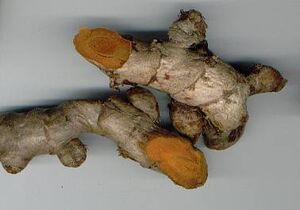
Turmeric root

Ground turmeric
About turmeric[]
Turmeric (Curcuma longa) is a rhizomatous herbaceous perennial plant of the ginger family, Zingiberaceae. It is native to tropical South Asia and needs temperatures between 20°C and 30°C, and a considerable amount of annual rainfall to thrive. Plants are gathered annually for their rhizomes, and re-seeded from some of those rhizomes in the following season.
The rhizomes are boiled for several hours and then dried in hot ovens, after which they are ground into a deep orange-yellow powder commonly used as a spice in curries and other South Asian and Middle Eastern cuisine, for dyeing, and to impart color to mustard condiments. Its active ingredient is curcumin and it has a distinctly earthy, slightly bitter, slightly hot peppery flavor and a mustardy smell.
In medieval Europe, turmeric became known as Indian Saffron, since it was widely used as an alternative to the far more expensive saffron spice.
Fresh turmeric[]
Fresh turmeric, or turmeric root, resembles fresh ginger root. It is used in much the same way as fresh ginger.
Ground turmeric[]
Ground turmeric is the spice which gives curry its distinctive golden yellow colour. It is a deep orange-yellow powder commonly used as a spice in curries and other South Asian and Middle Eastern cuisine.
Turmeric leaves[]
In Indonesia, the turmeric leaves are used for Minangese or Padangese curry base of Sumatra such as rendang, sate padang and many other varieties.